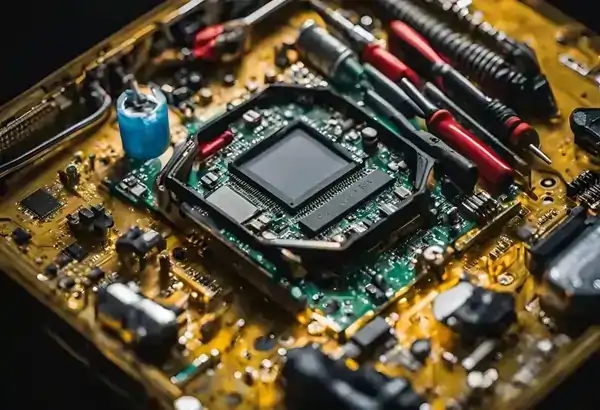When your Dell laptop greets you with a series of beeps instead of a normal startup, it’s trying to tell you something critical about its health. These Dell beep codes are part of the POST (Power-On Self-Test) process, a diagnostic tool built into your computer to identify hardware issues. If you’ve ever wondered, “Why is my Dell laptop beeping?” or “What does 3 beeps mean on a Dell computer?”, this guide is here to help you decode and fix the problem.
As someone with years of hands-on experience in Dell laptop diagnostics, I’ve had my fair share of encounters with these codes. Understanding these Dell POST Beep Codes can save you time, frustration, and potentially costly repairs. Let’s dive in!
What Are Dell POST Beep Codes?
POST Beep Codes (Power-On Self-Test Beep Codes) are diagnostic sounds produced by a laptop’s BIOS during startup. They’re your computer’s way of telling you something’s wrong before it can display an error on the screen. Each sequence corresponds to a specific issue, like RAM failure, CPU errors, or BIOS corruption. Understanding these codes can save time and money by pinpointing the exact problem.
Common Dell Beep Codes and Their Meaning
Here’s a breakdown of frequently encountered beep codes on Dell laptops:
1. 1 Beep – BIOS ROM Failure
- Issue: Indicates a failure in the system’s ROM BIOS or a BIOS Corruption.
- Solution: Reseat or replace the CMOS battery. If unresolved, update or reinstall the BIOS firmware by downloading it from Dell support using a USB stick; you will need to boot from it to perform the installation.
2. 2 Beeps – No Memory Detected
- Issue: The system is unable to detect RAM.
- Solution: Ensure RAM is properly seated; unplug/replug one memory at a time and check again. Test with alternate memory sticks to rule out faulty modules.
3. 3 Beeps – Chipset Error
- Issue: Motherboard failure, often due to a faulty chipset error.
- Solution: Refer to this guide for step-by-step instructions.
4. 4 Beeps – Memory Read/Write Failure
- Issue: The system struggles to read or write to the memory.
- Solution: Inspect the memory slots and modules for physical damage. Clean contacts with isopropyl alcohol if necessary.
5. 5 Beeps – CMOS Battery Failure
- Issue: CMOS battery is depleted or improperly connected.
- Solution: Replace the CMOS battery. This guide on troubleshooting power issues may help.
6. 6 Beeps – Video Card Error
- Issue: GPU or integrated graphics (chip) failure.
- Solution: Test external displays. Replace the GPU/Motherboard if the issue persists.
7. 7 Beeps – CPU Failure

- Issue: Processor error.
- Solution: This often requires professional repair. Contact Dell Support.
Continuous Beeping
- Issue: Potential motherboard failure.
- Solution: Power down, reseat components, and retest. Refer to this guide on fixing laptops that won’t turn on.
Diagnosing Beep Codes: A Step-by-Step Process
Step 1: Identify the Beep Code
Count the sequence of beeps. If the pattern repeats, note it down carefully.
Step 2: Refer to Dell Laptop error Beeps Chart
Check the official chart for your laptop model.
Step 3: Perform Basic Diagnostics
- Disconnect peripherals.
- Check for visible hardware damage.
- Reseat RAM and the CMOS battery.
Step 4: Run Dell Diagnostics. Most Dell laptops have an onboard diagnostic tool. Power off, hold the Fn key, and turn the laptop back on to access it.
Troubleshooting Dell Beep Codes: Common Fixes
- BIOS Update
Outdated firmware can cause boot issues. Ensure your BIOS is up-to-date. Use a USB drive to reinstall the BIOS if the laptop doesn’t boot. - Reseat Components
Loose hardware connections are a frequent culprit. Carefully reseat RAM, storage drives, and graphics cards. - Replace Faulty Hardware
Beep codes often indicate failing components. Swap them with tested replacements to confirm the issue.
When to Seek Professional Help

DIY troubleshooting may indicate severe hardware damage if it doesn’t resolve the problem. Contact Dell Support or consult a technician if:
- The laptop emits continuous beeping.
- Diagnostic tools fail to identify the issue.
- Replacement parts don’t solve the problem.
Final Thoughts
Dell POST beep codes are valuable for quickly diagnosing and resolving laptop issues. You can avoid downtime and expensive repairs by understanding and addressing these signals. If you’re facing persistent boot issues, check out this comprehensive guide on Dell laptop troubleshooting.
FAQs on Dell POST Beep Codes
1. What do Dell beep codes mean?
They are diagnostic signals from the BIOS indicating specific hardware issues.
2. How can I fix a laptop that beeps but won’t start?
Start by identifying the beep code, reseating components, and, if possible, updating the BIOS.
3. What does 3 beeps mean on a Dell computer?
It typically points to a Chipset error. Call a technician; he should replace the motherboard in most cases.
4. Is there a way to reset BIOS settings if my laptop beeps?
Yes, remove and replace the CMOS battery to reset the BIOS. This guide can help with troubleshooting power issues.
5. What should I do if I hear multiple beeps from my Dell laptop?
Consult the beep code chart for your model and follow the troubleshooting steps.


